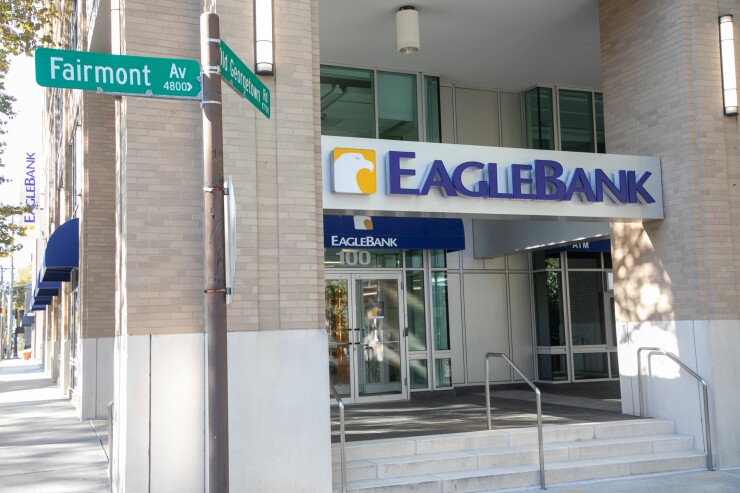
The threat of
Eagle Bancorp, a small bank just outside of Washington D.C., took a $70 million loss in the second quarter due to troubled office loans. The company's share price fell more than 20% on Thursday, a huge daily drop in the world of bank stocks.
After interest rates rapidly rose in 2022 and 2023, and the pandemic gave rise to work-from-home culture, banks with large exposures to office properties in big cities were in a bind. Selling the loans almost surely meant discounted deals, and holding onto them could mean major provisions to account for strained borrowers.
Hundreds of banks hold concentrations of CRE loans to capital far above a years-old regulatory guide of 300%.
In perhaps the most dramatic hit to banks,
At the $10 billion-asset Eagle, more than one-third of its $965 million
The bank has
Eric Newell, who joined Eagle as chief financial officer in September 2023 to help pivot its CRE strategy, told American Banker on Wednesday that the bank has built strong capital and reserves as it works through its office portfolio.
"That's really what you're seeing in the quarter, is us working through some of these office challenges and addressing that valuation risk," Newell said.
Eagle's net chargeoff ratio jumped to 4.22% in the second quarter, up from 0.57% in the second quarter. The average charge-off rate across U.S. banks in the first quarter was 0.67%, per data from the Federal Reserve Bank of St. Louis. That figure's all-time peak since 1985, which came directly after the financial crisis in 2008, is 3%.
Eagle's provision shot up in the second quarter as the bank got more information about the valuation of office properties in the D.C.-Maryland-Virginia region. Newell said government cuts from the new Trump administration and its so-called Department of Government Efficiency have put pressure on office loans across the area, which Eagle accounted for in the second quarter, even though the bank has minimal direct exposure to government office properties.
Susan Riel, chair and CEO of the bank, said on the company's Thursday earnings call with analysts that the bank has made some progress on restructuring certain challenged office loans, and has prepped two nonaccrual office loans to sell. Eagle expects to close on a sale in the third quarter, though Newell said the average discount on those deals is about 40%.
"While the second quarter performance is disappointing, these steps are deliberate and designed to more quickly normalize provision expenses in the future," Riel said.
Newell said in the interview that the bank is also trying to balance when it's more effective to exit problem loans quickly with the potential for better execution on loans that take longer to resolve.
The bank's losses aren't over. Newell said Eagle will continue to charge off loans and bulk up provisions to reduce the bank's credit risk, but the worst may be behind it.
"Based on what I know now, the extent of the provision expense isn't anticipated to be as great as it was in the second quarter," Newell said. "But that's based on what I know now. We could take a different strategy or different approach on some loans that we have, [which] could pull forward some losses into the quarter that we're not anticipating."
Meanwhile, Eagle has also been trying to diversify its business away from a reliance on the struggling office sector — by growing commercial and industrial loans, building lower-cost deposits and expanding fee revenue from treasury management products.
Excluding the provisions, Eagle was profitable during the second quarter, reporting pre-provision net revenue of $31 million, roughly in line with expectations. The bank also upped its 2025 expectations for deposit growth, from 1-4% to 4-6%, and for noninterest income growth, from 35-40% to 40-45%.
But Eagle dampened its guidance in multiple categories, including loan growth, average earning assets, net interest margin and noninterest expenses.
Other banks with outsized commercial real estate portfolios have also made moves to pull different income levers. But the variance between banks' sizes, geographies and the types of loans on their books, even within the office sector, make comparing their earnings a bit of an apples-to-oranges game.
Like Eagle, though, BankUnited Inc. in Florida reported a higher level of nonperforming loans in the second quarter, primarily because of troubles from its office book. The $36 billion-asset bank migrated $117 million of loans to non-accrual status.
On the other hand, BankUnited also reduced its criticized and classified loans by $156 million, which President and CEO Rajinder Singh said was "one of the largest reductions we've seen in quite some time." BankUnited also saw its net chargeoff rate decrease from 0.33% to 0.27% in the second quarter.
Dime Community Bancshares, a similarly-sized bank to Eagle,




